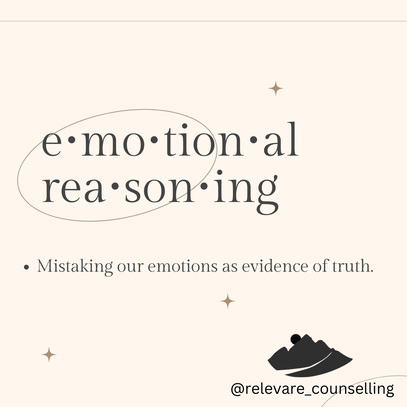|
Thinking traps are an excellent way of catching ourselves from falling into negative spirals or depressive episodes. It’s hard not to fall into these traps sometimes, especially because our mind becomes primed to think this way when distressed as a form of coping. We must be careful not to pathologize ourselves or others when thinking traps occur. Being able to recognize thinking traps as they happen can be useful to help us unhook, step back and observe, and channel our energy into effective living.
Here are some classic types of thinking traps with their definitions, examples, and antidotes. Dichotomous Thinking
Overgeneralization
Selective Abstraction
Minimization
Arbitrary Inference
Emotional Reasoning
Unrealistic Expectations
Magnification
Catastrophizing
Personalization
Defensiveness
Isolation
Confirmation Bias
Fallacy of Change
Magical Thinking
Irreversibility
Personal Fable
Imaginary Audience
0 Comments
It’s normal to get angry, but depending on how we use that anger, we can go from being frustrated to something more intense (e.g., rage). Knowing what the different types of anger are and what to do with them can help during your difficult moments when life keeps adding on those little—or big—stressors.
Source: Busting Common Myths About Anger by Mental Health Academy (2021) Go ahead, get trampled by a rhino. Go ahead, get mugged and left for dead. Me, I'm just your mother, what do I know? I only bathed and changed and nursed you. Go ahead and leave me, I deserve it. Let me die alone here, be my guest. When it's too late, you'll see, just wait, Mother knows best! —Mother Gothel, Tangled (2010) Right now, my two oldest girls are obsessed with the movie Tangled. Everyday Alexa is booming the soundtrack on repeat. Every. Single. Day. But as I’ve listened repeatedly, I noticed more and more the psychological impact that Mother Gothel has. She isn’t the villain because she kidnapped a baby—yes, that’s bad. But what makes her a villain is how she manipulates and controls Rapunzel, most noticeably through: Gaslighting. Gaslighting is the act of crazy-making. It’s a way of controlling another person by making them question themselves, their emotions, and their reality. It’s calling a person selfish when they’re just trying to take care of themselves or set a healthy boundary. It’s throwing back a person’s emotions—instead of listening/validating—and saying, “Your emotions aren’t my problem. That’s your fault.” Or claiming, “I never said that!” when they clearly did. It’s making a person doubt their ability to succeed at a task by making you feel that if you were to ever leave, you would leave “safety” and doom yourself to a miserable life of failure, loneliness, and pain. What was that thing they convinced you was so bad to do? Oh, just take a job. No, not something major like, “Don’t join a cult! Are you crazy?” But, “Don’t leave me because I need to be in control, not you.” If you listen to Mother Gothel’s song Mother Knows Best you’ll hear many examples of gaslighting. She makes Rapunzel doubt herself by pointing out made up character defects such as: not being able to survive on her own, sloppy and clumsy, “Plus, I believe, getting kind of chubby.” And if injury weren’t enough, she adds, “I’m just saying because I love you.” This is what makes the victim feel so crazy. It’s the combination of harm with something that should feel good: Love. Hopefully you see now why victims of gaslighting, narcissists, and abuse of all kinds have such a hard time opening up to themselves and others. What’s more is how at the beginning of the film, Rapunzel is seen doing what seems like an impossible amount of chores only to realize it’s only 7:15! Victims of gaslighting are very productive, active people. So when they’re criticized for not doing enough, that’s what is crazy. If they weren’t doing enough, it would likely make sense. Now, let me be bold and give a few suggestions for those of who you want to know how to help without it turning into gaslighting:
*Scott, B. & Briere, J. (2006). Principles of Trauma Therapy: A Guide to Symptoms, Evaluation, and Treatment (DSM-5 Update).
†Canadian Psychological Association (2017). Canadian Code of Ethics for Psychologists (Fourth Edition). “I’m broken.” “Who isn’t? Life breaks us. Then we fill the cracks with something stronger.” —Brandon Sanderson, Oathbringer Kintsugi is the Japanese art of mending broken pottery with golden lacquer, highlighting imperfections instead of disguising them. It literally means “to join with gold”. It’s an interesting philosophy, especially in the context of mental health. Most of the time, we seek to show a happy face to the world through social media, insist everything is fine when our loved ones express concern, and crack a little further when we hear friends joke about the hidden parts of our soul—confirmation not to dare show our true selves for risk of losing any semblance of normalcy and stability.
But kintsugi is a different approach. Kintsugi belongs to the philosophy of wabi sabi—that which is broken, simple, and weathered is more beautiful for being so. It is beauty in imperfection. There’s a story about one Sen no Rikyū, considered the first to understand the core of wabi sabi philosophy. The story goes that once, when he was hosted as a dinner guest, the host had laid out an expensive tea jar, hoping it to be noticed by Rikyū. But instead, Rikyū was more intrigued by a tree branch swaying in the wind outside. Afterward, the host smashed the tea jar, upset. Others collected the broken pieces and through kintsugi, mended the jar. When Rikyū next visited, he noticed the jar and said, “Now, it is magnificent.” I believe we are beautiful not because we haven’t been “tainted” by trauma. Or that we’re beautiful despite our weaknesses. I believe we are beautiful because of our brokenness. Accepting our brokenness is not a death sentence, it’s the key to authenticity. To be loved for who we are, completely. To move freely in new relationships instead of being controlled by the pain and trauma of the past. To find connection in our low moments and worthiness in our highs. To understand that now, because you are broken, you are magnificent. Two blind men waited at the end of an era, contemplating beauty. They sat atop the world’s highest cliff, overlooking the land and seeing nothing. “Can beauty be taken from a man?” the first asked the second. “It was taken from me,” the second replied. “For I cannot remember it.” This man was blinded in a childhood accident. “I pray to the God Beyond each night to restore my sight, so that I may find beauty again.” “Is beauty something one must see, then?” the first asked. —Brandon Sanderson, Words of Radiance A story in a story, but an interesting question, nonetheless. The story continues with the two men debating beauty by examining all the different senses and how beauty can be felt by each one. To hear music, to feel a sculpture’s curves and slopes, the taste and smell of a chef’s masterpiece, or the intellect of mind and philosophy.
“Very well,” said the second, “But what if your ears were removed, your hearing taken away? Your tongue taken out, your mouth forced shut, your sense of smell destroyed? What if your skin were burned so that you could no longer feel? What if all that remained to you was pain?” Mental health struggles can feel much like the question proposed in this fictional story. What if all that we felt—in one sense or another—were taken from us, leaving us only with pain? In this supposed situation, has beauty been taken from us? It sure feels that way when battling depression, loss, job burnout, frequent relationship disconnection, and other mental health struggles. It’s the feeling of not feeling, a consuming emptiness that steals away your joy. Can beauty—meaning in your life—be found when all you feel is pain? The short answer is yes, there is still beauty for you to experience in life no matter what hardships you’ve gone through. The long answer is that beauty is not something that can be given to you. It would seem nice if it could, just like going to the mall and picking up an item we deem valuable. But the beauty I refer to is something that transcends monetary or temporal things. It transcends even our senses of touch, taste, sound, sight, and smell. This is called the small self. A study in 2015 had students look up 200-feet tall eucalyptus trees for one minute. After, students reported feeling less self-centered and behaved more generously when given the chance to help someone. In this small self state we also have higher levels of oxytocin (the bonding hormone). When bonding—or connecting—in the small self, you experience something bigger than yourself. You might feel it when you worship at your church or mosque, when you do something creative, or engaging with someone else’s creativity through music and art. For holocaust survivor Victor Frankl, it came through choosing one’s own attitude, to choose one’s own way evidenced as he saw men in concentration camps comforting others and giving away their last piece of bread. For me, it came as I stood outside one winter evening and watched, through the front window, my wife reunite with our three girls after a traumatic surgery and loss of our fourth miscarriage. I could not help but pause for a moment and take in the scene. I remember the snow falling, the feeling of cold air, and the reflections of Christmas lights as I stood there with two car seats in my hand. After an experience that stole my beauty, that left with me pain, I felt in that moment a connection to something greater than myself. The pain didn’t go away, but it did lessen. And overtime, taught me many more beautiful truths. Can beauty—meaning in your life—be found when all you feel is pain? I think beauty is more than just when the pain lessens. But when the pain itself is transformed because it has meaning. As Victor Frankl said, “If there is meaning in life at all, then there must be meaning in suffering.” “To show you the way back from dark places into which you have strayed. To show you the way forward through dark places into which you must go.” —Terry Brooks, Antrax When mental health struggles arise, it can feel like we are enveloped in darkness. Some people say that life turns a dismal grey. Others manage to feel lonely in a room full of people they love and are loved by. You may begin to doubt yourself, even feel crazy at times. And those places that once brought you solace become gossamer threads of memory where what remains only serves as judgement about what you can never have again: peace, hope, and happiness.
If you feel you have strayed into dark places, there is still hope. In fact, those dark places hold the very answers you may be looking for. However, answers are cheap when you feel broken and alone, but here are three ways you can find hope again as you venture back from your dark places.
The journey out of your dark places is not something you can do alone. And as moving around in the dark is bound to have some stumbles, so too will your journey of recovery and healing. Therapy can be a safe place for you to explore your emotions and relationships, your hopes and dreams, and support you as you come back from the dark places into which you have strayed. |
Lee AtwoodLee Atwood is a psychologist and manages his private practice, Relevare Counselling, in Calgary, AB. He offers in-person and online services for mental health issues such as: sex/porn addiction, couples counselling, job burnout, stress reduction, parenting, religious trauma, men’s issues, and helping people on their journey of recovery and healing.
Archives
January 2023
|







 RSS Feed
RSS Feed